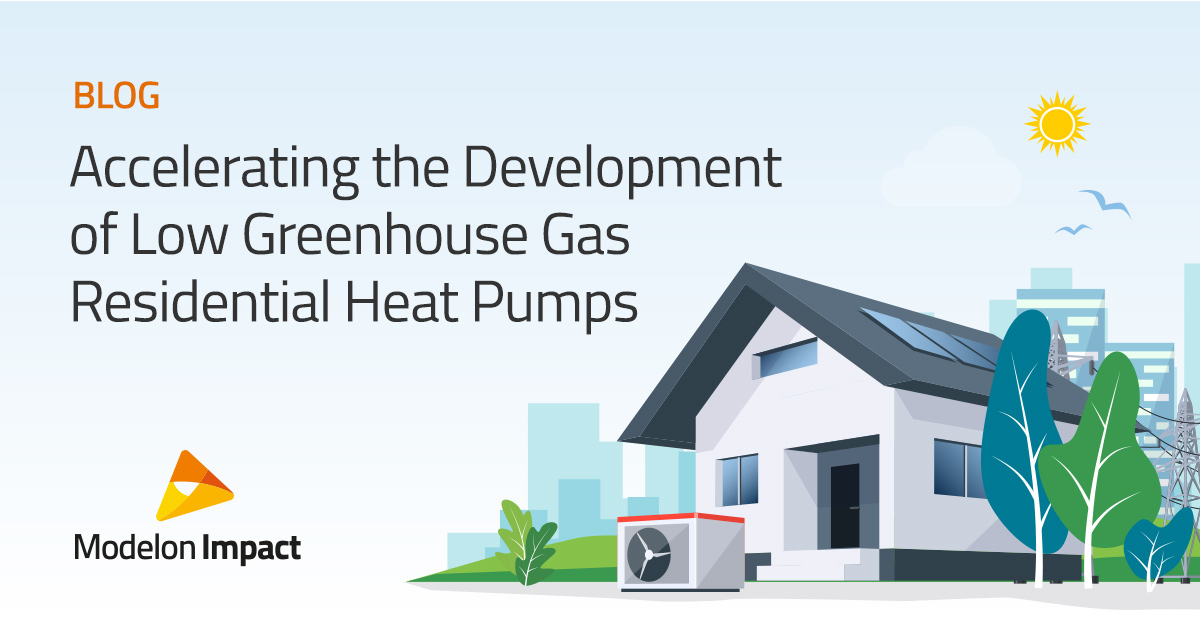Accelerating the Development of Low Greenhouse Gas Residential Heat Pumps

As the climate crisis spends more time in the headlines, heat pumps are often celebrated as a potent tool for both addressing climate change and making sure global populations can survive and thrive in a warmer world. But while heat pumps’ efficiency is extremely attractive, their reliance on working fluids with high global warming potentials (GWP) is an obvious problem.
The Vicious Cycle of Climate Change and Climate Control
According to a report released by World Weather Attribution the life-threatening heat waves and massive wildfires seen throughout July 2023 “would have been virtually impossible to occur in the US/Mexico region and Southern Europe if humans had not warmed the planet by burning fossil fuels.” 2023’s extreme cold-weather events, including record-breaking snow and cold in Texas and subtropical southern Japan, are likely also most reasonably attributed to human-caused climate change (which has accelerated arctic warming and thus disrupted the jet stream).
Much of our fossil fuel consumption is tied to heating and cooling. Globally, around 25% of all energy is used on heating or cooling for residential or commercial buildings. In the US, more than 40% of all carbon dioxide emissions come from heating, cooling, and hot water production. That figure is bound to rise as average temperatures rise. Already, AC installations are expected to triple by 2050. The warming climate is increasing the need for climate control in our buildings, which, in turn, is further deteriorating our global climate.
The Refrigerant Problem
Heat pump systems offer impressive gains in efficiency over conventional HVAC systems, significantly reducing energy demand (and thus decreasing carbon and greenhouse gas emissions). But they rely on refrigerants that are themselves potent greenhouse gasses. To maintain regulatory compliance (and avoid accelerating the climate crisis we’re working to address), manufacturers need to rapidly shift to new working fluids without compromising on performance or driving up costs.
Until recently, most heat pumps used fluorocarbon refrigerants like R407C, R410A or R134A. These are all powerful greenhouse gasses at ambient temperatures. For example, in 2019, roughly 80% of the heat pumps sold used R-410A refrigerant, which has a global warming potential 2088 times that of CO2.
Regulations in the EU and US are mandating a shift away from these working fluids for good reason, phasing many out within the next year. Ideally, we’ll be able to produce heat pumps that at least maintain current levels of efficiency while using a low GWP refrigerant. But that’s easier said than done.
Challenges Posed by Alternative Refrigerants
There are several good non-synthetic and synthetic candidates to replace current high GWP heat pump refrigerants. One popular candidate is propane (called R-290 in this context). Propane has been used as a commercial refrigerant for roughly a century. It has similar properties to phased-out synthetics like R-22 and R-134a, but with a minuscule impact on the atmosphere (e.g., while R-134a has a GWP of 1430, propane’s GWP is just 0.072). But it’s extremely flammable, which is extremely unattractive for a home HVAC system.
Meanwhile, using CO2 itself as a refrigerant for residential heat pumps is once again gaining traction. CO2 (aka R-744) has been used as an industrial refrigerant since the mid-1800s. It’s non-toxic, non-flammable, has a low GWP, and can operate much more efficiently than other refrigerants at both high temperature range and at low ambient temperatures. This makes it possible to design heat pump systems that perform better in colder climates and can generate hot water (thus replacing other greenhouse-gas emitting/high-carbon footprint mechanicals from the home).
Additionally, as next gen refrigerants are commercialized by chemical producers, validating their performance as direct replacements for existing high GHG refrigerants under real-world operating conditions is essential. Low flammability, low GWP, and low ODP make next gen refrigerants intriguing alternatives.
“Of course, it’s not as easy as a drop-in replacement,” explains Lixiang Li, a Senior Simulation Engineer with Modelon. “There are many practical aspects, both from the actual system and from simulation.”
For example, while CO2 heat pumps are attractive because of their safety and advanced performance, they pose design challenges:
To be used as a working fluid in heat pump systems, CO2 requires high pressure. This calls for thick-walled components and has a cascading effect on many other components throughout the HVAC system.
“It’s just not as trivial as just drop-in replacement,” Li notes, “not from the simulation side and not from a real system perspective either.”
Comprehensive Simulations for Heat Pump and Refrigerant Innovation
On a daily basis, Li is responsible for the operation of Modelon’s global Energy and HVAC team. Along with an experienced engineering team, he helped develop the air conditioning and other thermal system simulation modeling libraries and has collaborated with clients working to address the carbon footprint of heat pumps and transition to more eco-friendly refrigerants.
“We have done some studies with some longtime customers,” he recalls, “swapping out refrigerants to see how the system responds, in terms of performance. Those studies can be enabled using some simpler models” to explore basic substitutions or calibrations.
“But the real power comes in using more comprehensive models. We often help customers who are making long-term decisions for their next gen systems. The comprehensive models and detailed models are helpful in that sense. There are many engineering concerns and safety concerns, and we definitely don’t want to be using the real system and find out later, oh, that doesn’t work out because of A, B, or C. That’s where simulation becomes essential.”
Modelon Impact’s cloud-native simulation modeling and collaboration platform streamlines engineering processes. Our component libraries allow for multi-domain physical modeling and simulation, including support for a wide variety of alternative refrigerant media models. Both are optimized so that you can explore new concepts, validate and calibrate solutions, and bring better heat pump systems to market. Reach out and let us help you envision your next innovation.


